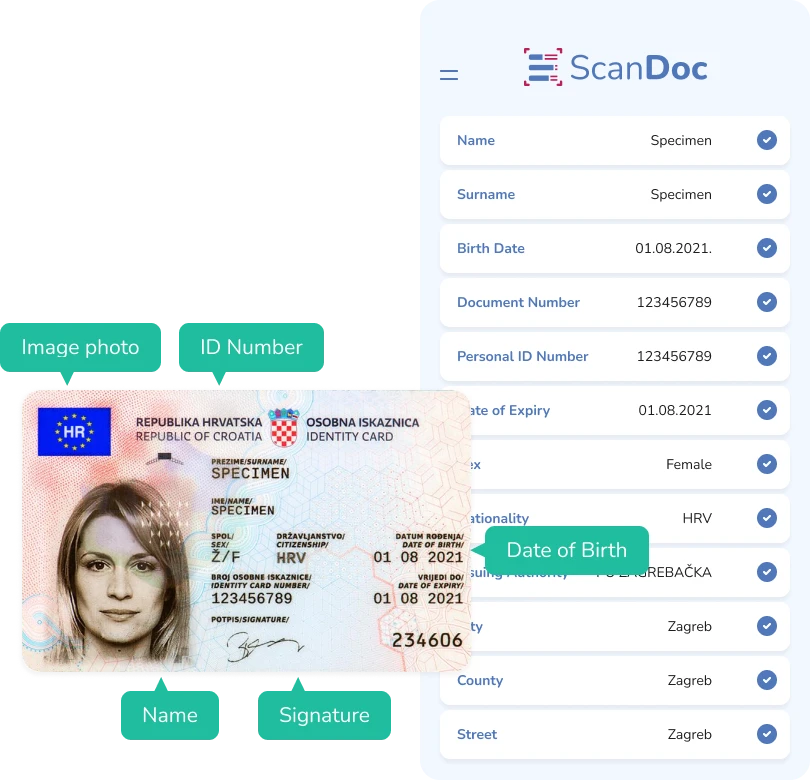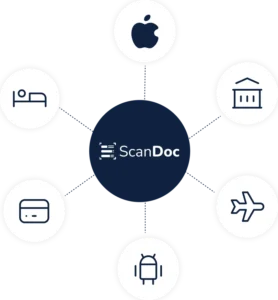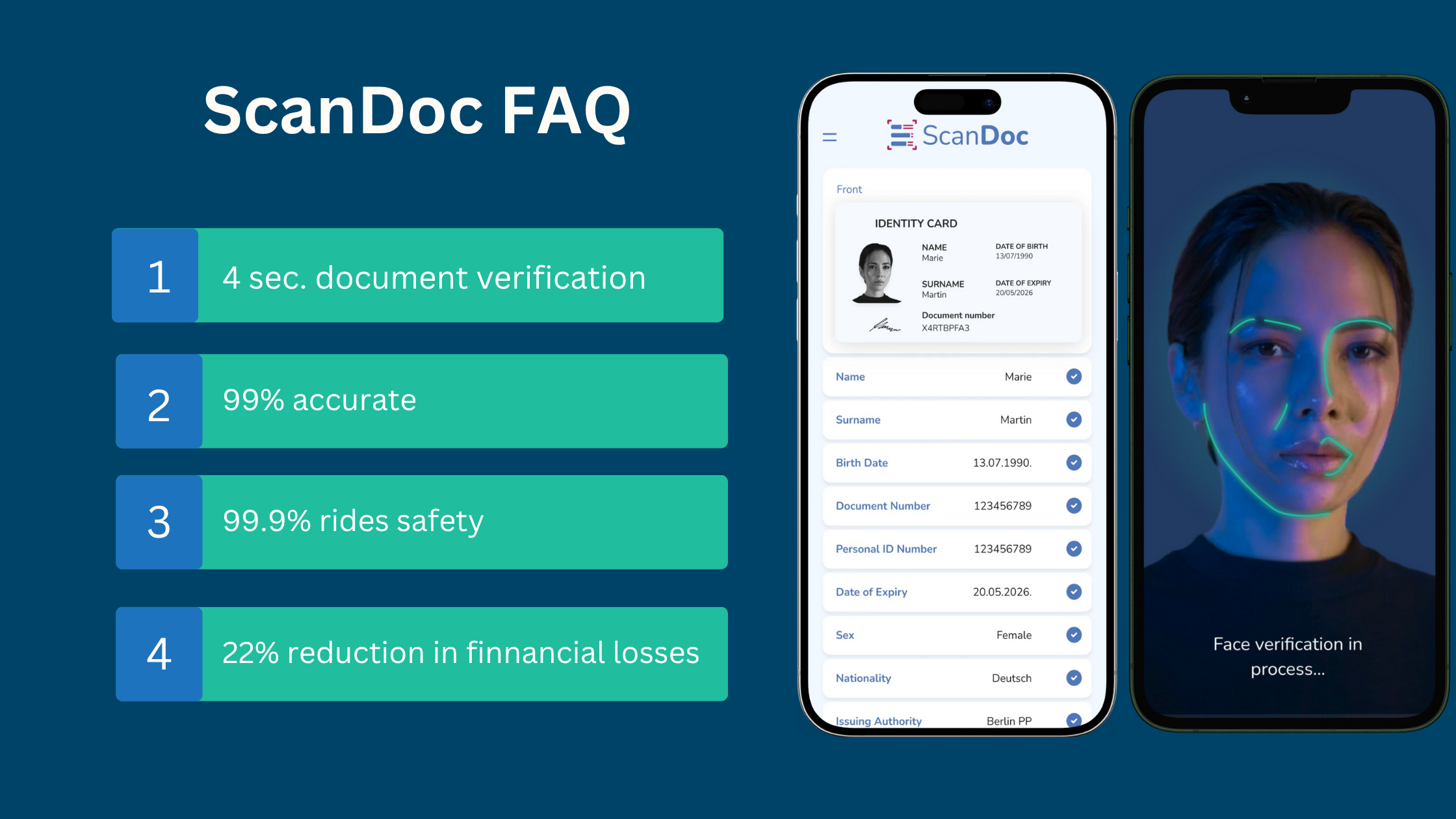ID and Passport Scanning Solutions

ID and passport scanning solutions combine advanced software and hardware to capture and extract personal information from identity documents efficiently.
These systems rely on state-of-the-art AI techniques, offering a highly reliable and accurate way to process document data for various applications. AI-based ID and passport scanning solutions, like ScanDoc, represent the latest advancements in document processing.
Unlike traditional mobile apps, these AI-driven solutions use advanced Optical Character Recognition (OCR) and Machine-Readable Zone (MRZ) technologies to extract data from documents and transfer it into digital systems.
One of the key features of AI-powered scanning solutions like ScanDoc is its cross-platform compatibility.
The software can be implemented on various hardware devices and supports both iOS and Android platforms. Utilizing advanced AI and deep learning techniques, ScanDoc can recognize document templates and perform both OCR and MRZ extractions.
The system then compares the results of OCR and MRZ data to ensure accuracy before generating the final extracted information.
Additionally, ScanDoc includes face recognition capabilities, which are critical for digital customer onboarding and complying with Know Your Customer (KYC) requirements.

How do ID and Passport Document Scanning Solutions Work?
At the core of any ID scanning solution lies a fundamental component: the camera. The first step is to capture an image of an identity document and subsequently subject it to examination.
The primary distinction between hardware-based and software-based mobile ID scanners lies in the shooting conditions.
The software leverages the capabilities of a user’s device, relying on the user’s accuracy in taking photos. This reliance often prompts users to retake images due to issues like poor lighting, shadowing, or blurriness.
Desktop and embedded passport readers offer the advantage of examining documents in controlled light sources. These devices provide optimal shooting conditions, free from ambient light, enabling features like capturing UV luminescence without interference.
From a procedural standpoint, utilizing an ID scanner involves a 3-step process of scanning and verifying an ID with a passport reader.
Capturing a high-quality document image is crucial, as low-quality images may hinder information readability and compromise forgery detection.
The next step involves reading text symbols within images, translating them into data, and sending that data to one or more systems for further use.
This functionality, prevalent in settings like hotels, simplifyes processes and improve customer experience by eliminating manual data entry.
The last verification stage serves security and compliance purposes, ensuring the authenticity and validity of the provided ID.
Various methods, depending on the hardware or software solution, range from checking expiration dates to incorporating biometrics.
For instance, the document reader employs authenticity checks by matching data from the visual inspection zone with information encoded in security features like machine-readable zones or barcodes.
Professional document readers excel at extracting and verifying diverse data, including:
- Document Type
- Textual and numeric fields (name, ID number, expiration date, date of birth, address, etc.)
- MRZ – Machine-readable zone (code on the back of the ID)
- Barcodes & QR code
Key Benefits of Using ID and Passport Scanning Solutions
Simplify the Identity Verification Process
One primary advantage of ID and passport scanning solutions is the simplification of the extraction and verification process. Automate the extraction and verification of information from identity documents, significantly reducing the time and effort required for manual checks.
This is particularly valuable in settings such as airports, hotels, and financial institutions, where quick and accurate identity verification is essential.
Improve Security and Fraud Prevention
ID and passport scanning solutions play a crucial role in improving security and preventing fraud.
By employing advanced scanning techniques and cross-referencing data against security features embedded in documents, these scanning solutions help identify counterfeit or altered documents.
This is crucial for maintaining the integrity of sensitive environments, such as border control and government agencies.
Data Accuracy
Automation provided by ID and passport scanners significantly improves data accuracy. Manual data entry could cause errors, but scanners eliminate this risk by extracting information directly from documents.
This ensures that the data used for verification and record-keeping is precise, reducing the likelihood of mistakes that could lead to security problems or operational inefficiencies.
Simplify Customer Experience
For businesses in hospitality, including hotels and car rental services, ID and passport scanners contribute to an enhanced customer experience. The swift and accurate verification facilitated by these scanners speeds up processes like check-ins, reducing wait times and enhancing overall customer satisfaction.
Integration with Digital Systems:
ID and passport scanners integrate with digital systems, allowing for efficient data storage and retrieval. This integration facilitates the creation of electronic databases, making it easier for organizations to manage and access information. This is particularly important for businesses that prioritize digital record-keeping and seek to leverage data analytics for decision-making.
Versatility Across Industries
ID and passport scanners are versatile tools applicable across various industries. From immigration checkpoints to hotel receptions, these scanners provide a standardized solution for identity verification, catering to the diverse needs of different sectors.
In summary, the key benefits of using ID and passport scanners include streamlined verification processes, enhanced security measures, improved data accuracy, efficient compliance with regulations, an improved customer experience, seamless integration with digital systems, and versatility across industries.
Collectively, these advantages contribute to a more secure, efficient, and compliant operational environment.

Use Cases for ID and Passport Scanning Solution
The need for online identity verification is becoming increasingly popular across all industries, from opening online bank accounts and age verification to online check-in for flights or hotels.
The suppliers must simplify the process and make it fast and efficient for the end users.
Below, you will be able to see many different use cases for identity verifications.
Digital Customer Onboarding
Customer onboarding for highly regulated industries like finance is very complex and requires an additional level of security. Opening a bank account online requires identity verification right away.
Therefore, for digital customer onboarding, banks use reliable partners that can, in a matter of seconds, extract data from the document and verify the person using liveness face recognition.
Once the data extraction and face recognition have been performed, the information is sent to be verified based on which results have been created. Such innovative approaches to digital customer onboarding have proven applicable across various industries on a global scale.
KYC Automation
Know Your Customer (KYC) is a transformative process that leverages advanced technologies to streamline customer identification and verification processes in various industries. KYC is a crucial component in sectors such as finance, healthcare, and telecommunications, where regulatory compliance and fraud prevention are very important.
KYC automation uses cutting-edge technologies such as AI, deep learning, and OCR to collect, analyze, and verify customer information efficiently. By automating these processes, organizations can significantly reduce the time and resources traditionally required for manual KYC checks.
This not only accelerates onboarding procedures but also improves overall operational efficiency.
One of the primary benefits of KYC automation is mitigating risks associated with identity theft and fraudulent activities. Advanced algorithms can cross-reference customer data against global databases, sanctions lists, and watchlists, ensuring a more thorough and accurate verification process.
Furthermore, KYC automation enhances the customer experience by reducing the need for extensive paperwork and in-person verification. Customers can undergo identity verification remotely, often through digital channels, making the onboarding process more convenient and user-friendly.
Remote/Online Check-ins
During and after the COVID-19 pandemic, more companies moved from traditional in-person check-in to remote, contactless check-in. Many industries, such as hospitality and airlines, have decided to provide both desk and remote options.
Online check-in options significantly reduce long lines at hotels and airports. Customers simply scan their documents and all needed information from their documents is automatically transferred into the system.
With ScanDoc’s flexible scanning solution, many hotels reduce online check-in to less than 60 seconds.
Age Verification
Implementing measures to restrict access to certain content, services, products, and venues for underage customers is a vital process for various businesses, ranging from the sale of alcohol in supermarkets to the operation of casinos and adult-only events.
Document scan and utilization of OCR and MRZ extraction enables automatic age checks. Professional passport readers, equipped with OCR and MRZ techniques, not only facilitate seamless age verification but also mitigate risks associated with counterfeit documents or instances where original documents are borrowed by someone else.
This is achieved through comprehensive cross-checks, including biometric data verification.
For an added layer of security, consider incorporating advanced solutions like the ScanDoc Age Verification. It enables the automatic identification of a person’s age through photographs or selfies, ensuring that the presenter of the document is the person claimed to be.
By leveraging such techniques, businesses can improve their ability to enforce age restrictions effectively and maintain a secure environment.
Why ScanDoc?
Implementing ScanDoc’s flexible scanning solution for data extraction, validation, and face recognition offers companies a comprehensive and efficient solution for improving digital customer onboarding.
ScanDoc excels in data extraction, ensuring that relevant information from various documents, such as IDs and passports, is accurately and swiftly captured. This is critical for digital customer onboarding, where precise data extraction lays the foundation for adequate customer identity verification.
Validation is another key strength of ScanDoc. By leveraging advanced algorithms and cross-checking capabilities, it verifies the authenticity of documents and mitigates the risks associated with fraudulent or altered information.
This ensures that the customer data collected during onboarding is accurate and trustworthy, contributing to a more secure and compliant operational environment.
Incorporating face recognition technology within ScanDoc adds an extra layer of security. By enabling the identification of individuals through facial features, ScanDoc enhances the verification process, ensuring that the person presenting the documents is indeed the legitimate owner.
In the context of the online check-in and remote identity verification processes, ScanDoc plays a pivotal role in expediting these procedures. The seamless integration of ScanDoc facilitates swift data extraction and validation, enabling a more efficient and user-friendly online check-in experience.
By accelerating online check-ins, enhancing data accuracy through validation, and incorporating face recognition for identity verification, ScanDoc becomes an important solution in pursuing a seamless, secure, and technologically advanced onboarding experience.
Click here to request a personal demo.





